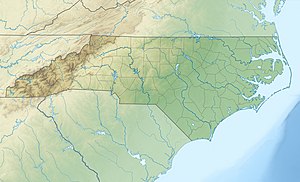Canebreak Branch
| Canebreak Branch Tributary to Lanes Creek | |
|---|---|
| Location | |
| Country | United States |
| State | North Carolina |
| County | Anson |
| Physical characteristics | |
| Source | Cribs Creek divide |
| • location | about 0.5 miles southwest of Kikers, North Carolina |
| • coordinates | 35°03′55″N 080°13′47″W / 35.06528°N 80.22972°W[1] |
| • elevation | 452 ft (138 m)[2] |
| Mouth | Lanes Creek |
• location | about 2 miles north of Griffins Crossroads, North Carolina |
• coordinates | 35°02′27″N 080°13′01″W / 35.04083°N 80.21694°W[1] |
• elevation | 318 ft (97 m)[2] |
| Length | 1.35 mi (2.17 km)[3] |
| Basin size | 1.19 square miles (3.1 km2)[4] |
| Discharge | |
| • location | Lanes Creek |
| • average | 1.44 cu ft/s (0.041 m3/s) at mouth with Lanes Creek[4] |
| Basin features | |
| Progression | Lanes Creek → Rocky River → Pee Dee River → Winyah Bay → Atlantic Ocean |
| River system | Pee Dee River |
| Tributaries | |
| • left | unnamed tributaries |
| • right | unnamed tributaries |
| Bridges | Birmingham Road, Kiker Road, Johnson Road |
Canebreak Branch is a 1.35 mi (2.17 km) long 1st order tributary to Lanes Creek in Anson County, North Carolina. This is the only stream of this name in the United States.
Course[edit]
Canebreak Branch rises about 0.5 miles southwest of Kikers, North Carolina. Canebreak Branch then flows southeast to meet Lanes about 2 miles north of Griffins Crossroads.[2]
Watershed[edit]
Canebreak Branch drains 1.19 square miles (3.1 km2) of area, receives about 48.0 in/year of precipitation, has a topographic wetness index of 390.95 and is about 60% forested.[4]
References[edit]
- ^ a b "GNIS Detail - Canebreak Branch". geonames.usgs.gov. US Geological Survey. Retrieved 21 October 2020.
- ^ a b c "Lanes Creek Topo Map in Anson". TopoZone. Locality, LLC. Retrieved 21 October 2020.
- ^ "ArcGIS Web Application". epa.maps.arcgis.com. US EPA. Retrieved 21 October 2020.
- ^ a b c "Watershed Report | Office of Water | US EPA". watersgeo.epa.gov. Retrieved 21 October 2020.


